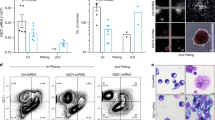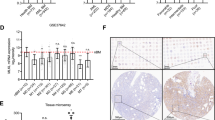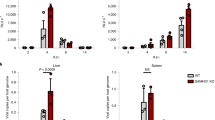Abstract
During the initial stage of Friend virus-induced erythroleukemia in mice, interaction of the viral protein gp55 with the erythropoietin receptor, and other host factors, drives the expansion of erythroid precursor cells. Recently, we demonstrated that the Friend virus susceptibility locus, Fv2, which is required for the expansion of infected cells, encodes a naturally occurring, N-terminally truncated form of the Stk receptor tyrosine kinase (Sf-Stk). Here we show that in vitro expression of Sf-Stk confers Friend virus sensitivity to erythroid progenitor cells from Fv2rr mice. Furthermore, our data reveal that Sf-Stk kinase activity and Y436, but not Y429, are required for Epo-independent colony formation following Friend virus infection. Introduction of a mutation that results in failure to bind Grb2 abrogates the ability of Sf-Stk to induce colonies in response to Friend virus, while the Grb2 binding site from EGFR restores this response. Consistent with the ability of Grb2 to recruit SOS and Gab1, the Ras/MAPK and PI3K pathways are activated by Sf-Stk, and both of these pathways are required for gp55-mediated erythroblast proliferation. These data clearly demonstrate a requirement for signaling through Sf-Stk in the Epo-independent expansion of Friend virus-infected cells, and suggest a pivotal role for Grb2 in this response.
This is a preview of subscription content, access via your institution
Access options
Subscribe to this journal
Receive 50 print issues and online access
$259.00 per year
only $5.18 per issue
Buy this article
- Purchase on Springer Link
- Instant access to full article PDF
Prices may be subject to local taxes which are calculated during checkout






Similar content being viewed by others
References
Ben-David Y, Bernstein A . 1991 Cell 66: 831–834
Boccaccio C, Ando M, Tamagnone L, Bardelli A, Michiell P, Battistini C, Comoglio PM . 1998 Nature 391: 285–288
Bondurant MC, Koury MJ, Krantz SB . 1985 J. Gen. Virol. 66: 83–96
Clarke BJ, Axelrad AA, Shreeve MM, McLeod DL . 1975 Proc. Natl. Acad. Sci. USA 72: 3556–3560
Correll PH, Iwama A, Tondat S, Mayrhofer G, Suda T, Bernstein A . 1997 Genes and Function 1: 69–83
D'Andrea AD . 1992 Cancer Surveys 15: 19–36
Fixman ED, Fournier TM, Kamikura DM, Naujokas MA, Park M . 1996 J. Biol. Chem. 271: 13116–13122
Fournier T, Kamikura D, Teng K, Park M . 1996 J. Biol. Chem. 271: 22211–22217
Gong Q, Cheng A, Akk A, Alberola-Ila J, Gong G, Pawson T, Chan A . 2001 Nat. Immunol. 2: 29–36
Hoatlin ME, Kabat D . 1995 Trends Micro. 3: 51–57
Huff JL, Jelinek MA, Borgman CA, Lansing TJ, Parsons JT . 1993 Proc. Natl. Acad. Sci. USA 90: 6140–6144
Iwama A, Okano K, Sudo T, Matsuda Y, Suda T . 1994 Blood 83: 3160–3169
Iwama A, Yamaguchi N, Suda T . 1996 EMBO J. 15: 5866–5875
Jeffers M, Schmidt L, Nakaigawa N, Webb CP, Weirich G, Kishida Y, Zbar B, Vande Woude GF . 1997 Proc. Natl. Acad. Sci. USA 94: 11445–11450
Leonard EJ . 1997 Ciba Found. Symp. 212: 183–191
Li J-P, D'Andrea AD, Lodish HF, Baltimore D . 1990 Nature 343: 762–764
Liu Q-P, Fruit K, Ward J, Correll PH . 1999 J. Immunol. 163: 6606–6613
Longati P, Bardelli A, Ponzetto C, Naldini L, Comoglio PM . 1994 Oncogene 9: 49–57
Longley BJ, Tyrrell L, Lu SZ, Ma YS, Langley K, Ding TG, Duffy T, Jacobs P, Tang LH, Modlin I . 1996 Nat. Genet. 12: 312–314
Maina F, Casagranda F, Audero E, Simeone A, Comoglio PM, Klein R, Ponzetto C . 1996 Cell 87: 531–542
Moreau-Gachelin F, Tavitian A, Tambourin P . 1988 Nature 331: 277–280
Moriyama Y, Tsujimura T, Hashimoto K, Morimoto M, Kitayama H, Matsuzawa Y, Kitamura Y, Kanakura Y . 1996 J. Biol. Chem. 271: 3347–3350
Mowat M, Cheng A, Kimura N, Bernstein A, Benchimol S . 1985 Nature 314: 633–636
Nguyen L, Holgado-Madruga M, Maroun C, Fixman ED, Kamikura D, Fournier T, Charest A, Tremblay ML, Wong AJ, Park M . 1997 J. Biol. Chem. 272: 20811–20819
Nishigaki K, Hanson C, Ohashi T, Thompson D, Muszynski K, Ruscetti S . 2000 J. Virol. 74: 3037–3045
Nishigaki K, Thompson D, Hanson C, Yugawa T, Ruscetti S . 2001 J. Virol. 75: 7893–7903
Ohashi T, Masuda M, Ruscetti SK . 1995 Blood 85: 1454–1462
Park CY, Hayman MJ . 1999 J. Biol. Chem. 274: 7583–7590
Peace BE, Hughes MJ, Degen SJ, Waltz SE . 2001 Oncogene 20: 6142–6151
Persons DA, Paulson RF, Loyd MR, Herley MT, Bodner SM, Bernstein A, Correll PH, Ney PA . 1999 Nat. Genet. 23: 159–165
Piao X, Paulson R, van der Geer P, Pawson T, Bernstein A . 1996 Proc. Natl. Acad. Sci. USA 93: 14665–14669
Santoro MM, L P, Minetto M, Orecchia S, Cilli M, Gaudino G . 1998 Oncogene 17: 741–749
Schmidt L, Duh FM, Chen F, Kishida T, Glenn G, Choyke P, Scherer SW, Zhuang Z, Lubensky I, Dean M, Allikmets R, Chidambaram A, Bergerheim UR, Feltis JT, Casadevall C, Zamarron A, Bernues M, Richard S, Lips CJ, Walther MM, Tsui LC, Geil L, Orcutt ML, Stackhouse T, Lipan J, Slife L, Brauch H, Decker J, Niehans G, Hughson MD, Moch H, Storkel S, Lerman MI, Linehan WM, Zbar B . 1997 Nat. Genet. 16: 68–73
Smith DR, Vogt PK, Hayman MJ . 1989 Proc. Natl. Acad. Sci. USA 86: 5291–5295
Songyang Z, Shoelson S, McGlade J, Olivier P, Pawson T, Bustelo X, Barbacid M, Sabe H, Hanafusa H, Yi T, Ren R, Baltimore D, Ratnofsky S, Feldman R, Cantley L . 1994 Mol. Cell. Biol. 14: 2777–2785
Stefan M, Koch A, Mancini A, Mohr A, Weidner K, Niemann H, Tamura T . 2001 J. Biol. Chem. 276: 3017–3023
Yamamura Y, Senda H, Kageyama Y, Matsuzaki T, Noda M, Ikawa Y . 1998 Mol. Cell. Biol. 18: 1172–1180
Zhen Z, Giordano S, Longati P, Medico E, Campiglio M, Comoglio PM . 1994 Oncogene 9: 1691–1697
Acknowledgements
The authors would like to thank Drs A August and A Henderson for their technical advice concerning autophosphorylation studies and retroviral transduction techniques and Dr T Suda for the Stk docking site tyrosine mutant constructs. This work was supported in part by an American Cancer Society Postdoctoral Fellowship PF-01-121-01-LIB (LD Finkelstein), National Institutes of Health (NIH) grant RO1 HL66471 (PH Correll and RF Paulson), and a Junior Faculty Scholar Award from the American Society of Hematology (PH Correll).
Author information
Authors and Affiliations
Corresponding author
Rights and permissions
About this article
Cite this article
Finkelstein, L., Ney, P., Liu, QP. et al. Sf-Stk kinase activity and the Grb2 binding site are required for Epo-independent growth of primary erythroblasts infected with Friend virus. Oncogene 21, 3562–3570 (2002). https://doi.org/10.1038/sj.onc.1205442
Received:
Revised:
Accepted:
Published:
Issue Date:
DOI: https://doi.org/10.1038/sj.onc.1205442
Keywords
This article is cited by
-
A detailed analysis of F-MuLV- and SFFV-infected cells in Friend virus-infected mice reveals the contribution of both F-MuLV- and SFFV-infected cells to the interleukin-10 host response
Retrovirology (2022)
-
Humoral immunity in the Friend retrovirus infection model
Immunologic Research (2013)
-
Stat3 promotes the development of erythroleukemia by inducing Pu.1 expression and inhibiting erythroid differentiation
Oncogene (2009)
-
Significance of the entire C-terminus in biological activities mediated by the RON receptor tyrosine kinase and its oncogenic variant RON160
Journal of Experimental & Clinical Cancer Research (2008)
-
GRB2-mediated recruitment of GAB2, but not GAB1, to SF-STK supports the expansion of Friend virus-infected erythroid progenitor cells
Oncogene (2006)



